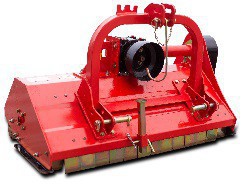The cost of operating a flail mower isn't just the purchase price. It also includes inspections, replacement parts, ongoing maintenance, and sometimes unforeseen repairs. A well-planned service schedule allows you to extend the life of your equipment, reduce expenses, and avoid seasonal breakdowns. In this post, we will show you how to develop a savings plan for the coming year step by step.
Why it's worth planning operating costs
-
Money savings – regular inspections and replacement of parts protect against serious breakdowns, the repair of which can be much more expensive.
-
Longer machine life – taking care of the flails, blades, and shafts minimizes their wear.
-
Higher work efficiency – an efficient mower means fast mowing, lower fuel consumption, and less downtime.
What is included in the annual operating cost of a flail mower?
-
Flails and Blades – replacement depending on the degree of wear (usually 2-4 times per season).
-
Bearings, belts, screws and nuts – components subject to natural wear and tear.
-
Technical inspections – inspection of the flail shaft, blade adjustment, lubrication and inspection of moving parts.
-
Fuel and oils – operating costs depend on operating time.
-
Unforeseen repairs – e.g., damage caused by collisions with stones or roots.
How to plan inspections to reduce costs
1. Divide the year into service intervals.
-
Spring (March-April) – shaft inspection, knife adjustment, replacement of worn parts.
-
Summer season (May-August) – routine inspections, lubrication, replacement of beaters and knives.
-
Autumn (September-November) – post-season inspection, preparation of the machine for winter storage, parts purchase plan for the following year.
2. Make a spare parts list
-
Beating tools, blades, bearings, screws, nuts, belts – it's worth having them in stock.
-
Stocking supplies help avoid interruptions in work and often reduce purchase costs.
3. Create a maintenance schedule
-
Mark maintenance dates on your calendar.
-
Include time for cleaning, lubrication, and adjustments.
-
If you have more than one machine, use a rotating schedule so that none of them is down at a critical moment.
How to avoid sudden breakdowns
-
Observe vibrations and unusual noise from the machine.
-
Don't put off replacing worn parts.
-
Keep simple service records – record replacement dates, parts used, and observations.
-
With a spare parts inventory, you can immediately Respond to minor faults before they become a major problem.
Summary
Regular inspections, planned parts replacement, and proper machine storage can significantly reduce operating costs and avoid downtime. You can prepare a schedule of activities and a parts kit now to start the new season fully prepared, without surprises and unnecessary expenses.












